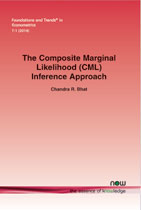The Composite Marginal Likelihood (CML) Inference Approach with Applications to Discrete and Mixed Dependent Variable Models
By Chandra R. Bhat, The University of Texas at Austin Department of Civil Architectural and Environmental Engineering, USA and King Abdulaziz University, Saudi Arabia, bhat@mail.utexas.edu
Abstract
This monograph presents the basics of the composite marginal likelihood (CML) inference approach, discussing the asymptotic properties of the CML estimator and the advantages and limitations of the approach. The composite marginal likelihood (CML) inference approach is a relatively simple approach that can be used when the full likelihood function is practically infeasible to evaluate due to underlying complex dependencies. The history of the approach may be traced back to the pseudo-likelihood approach of Besag (1974) for modeling spatial data, and has found traction in a variety of fields since, including genetics, spatial statistics, longitudinal analyses, and multivariate modeling. However, the CML method has found little coverage in the econometrics field, especially in discrete choice modeling. This monograph fills this gap by identifying the value and potential applications of the method in discrete dependent variable modeling as well as mixed discrete and continuous dependent variable model systems. In particular, it develops a blueprint (complete with matrix notation) to apply the CML estimation technique to a wide variety of discrete and mixed dependent variable models.
The Composite Marginal Likelihood (CML) Inference Approach with Applications to Discrete and Mixed Dependent Variable Models
The Composite Marginal Likelihood (CML) Inference Approach with Applications to Discrete and Mixed Dependent Variable Models takes a straightforward approach to illustrating the value of the CML method for the estimation of discrete and mixed dependent variable models in Econometrics. The monograph discusses theoretical aspects of CML methods, provides an overview of developments and applications of the CML inference approach, and explains why the approach can be particularly very effective for the estimation and analysis of high-dimensional heterogeneous data. In addition, it provides a blueprint (complete with matrix notation) to apply the CML estimation technique to a wide variety of discrete and mixed dependent variable model systems.
